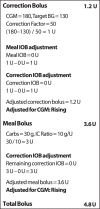Clinical Evaluation of a Novel CGM-Informed Bolus Calculator with Automatic Glucose Trend Adjustment
- PMID: 34491825
- PMCID: PMC8783627
- DOI: 10.1089/dia.2021.0140
Clinical Evaluation of a Novel CGM-Informed Bolus Calculator with Automatic Glucose Trend Adjustment
Abstract
Background: Expert opinion guidelines and limited data from clinical trials recommend adjustment to bolus insulin doses based on continuous glucose monitor (CGM) trend data, yet minimal evidence exists to support this approach. We performed a clinical evaluation of a novel CGM-informed bolus calculator (CIBC) with automatic insulin bolus dose adjustment based on CGM trend used with sensor-augmented pump therapy. Materials and Methods: In this multicenter, outpatient study, participants 6-70 years of age with type 1 diabetes (T1D) used the Omnipod® 5 System in Manual Mode, first for 7 days without a connected CGM (standard bolus calculator, SBC, phase 1) and then for 7 days with a connected CGM using the CIBC (CIBC phase 2). The integrated bolus calculator used stored pump settings plus user-estimated meal size and/or either a manually entered capillary glucose value (SBC phase) or an imported current CGM value and trend (CIBC phase) to recommend a bolus amount. The CIBC automatically increased or decreased the suggested bolus amount based on the CGM trend. Results: Twenty-five participants, (mean ± standard deviation) 27 ± 15 years of age, with T1D duration 12 ± 9 years and A1C 7.0% ± 0.9% completed the study. There were significantly fewer sensor readings <70 mg/dL 4 h postbolus with the CIBC compared to the SBC (2.1% ± 2.0% vs. 2.8 ± 2.7, P = 0.03), while percent of sensor readings >180 and 70-180 mg/dL remained the same. There was no difference in insulin use or number of boluses given between the two phases. Conclusion: The CIBC was safe when used with the Omnipod 5 System in Manual Mode, with fewer hypoglycemic readings in the postbolus period compared to the SBC. This trial was registered at ClinicalTrials.gov (NCT04320069).
Keywords: Bolus calculator; Continuous glucose monitoring; Hypoglycemia; Omnipod; Type 1 diabetes.
Conflict of interest statement
J.E.P. reports grant support and supplies, provided to his institution, from Insulet Corporation; grant support, provided to his institution, and consulting fees and speaker fees from Tandem Diabetes Care, Inc.; grant support, provided to his institution, and advisory board fees from Medtronic; grant support, provided to his institution, and consulting fees from Eli Lilly; and supplies, provided to his institution, from Dexcom, Inc., S.A.B. reports grants from Insulet, nonfinancial support from Dexcom, during the conduct of the study; grants and supplies from Tandem Diabetes Care, nonfinancial support from Roche Diagnostics; grants from Tolerion; and grants and supplies from Dexcom outside the submitted work. B.W.B. reports grant support to his employer Atlanta Diabetes Associates. M.K.V. reports grant support from Medtronic, Insulet, Tolerion, DexCom.; Speaker Panel for Abbott, DexCom; Past Employment Medtronic Diabetes. T.T.L., B.D., L.M.H., J.B.L., and E.B. are full-time employees of and own stock in Insulet Corporation. J.O. is a full-time employee of and owns stock in Insulet Corporation, and holds multiple patents related to the product used in the trial. M.M.C. and B.N. have nothing to disclose. No other conflicts of interest were reported.
Figures


References
-
- Bassi M, Minuto N, Fichera G, et al. : Practical approach to using trend arrows on real-time continuous glucose monitoring system in type 1 diabetes adolescents living camp setting treated with multiple daily injection or continuous subcutaneous insulin infusion insulin therapy. J Diabetes Sci Technol 2020:1932296820934803. - PMC - PubMed
Publication types
MeSH terms
Substances
Associated data
LinkOut - more resources
Full Text Sources
Medical
